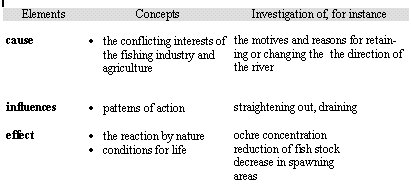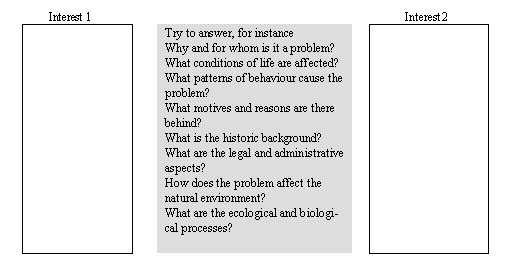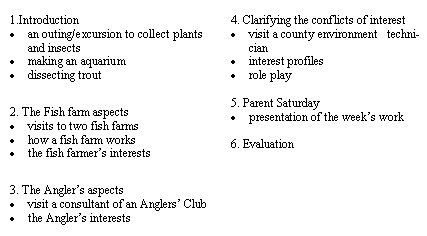What various elements in an environmental problem should be used in environmental education that ensure the students gain good insight?A concrete example related to the environmental issues connected with the straightening out of Skjern river could shed light on this.
The original environmental issue was a dispute between people with interests in fishing in Ringkøbing Fiord and those farmers whose land was cultivated down to the fiord. There was a conflict of interests. The conflict arose because an increase in land under cultivation through draining meant a straightening out of the river so the water would drain more swiftly from the fields.
Hence the fishing in the fiord and the spawning grounds in the river system were either destroyed or radically reduced, among other reasons, because the straightening of the river increased the level of ochre in the water. The interests of the fishing industry had to give way to agriculture – The Minister for the Environment spoke out bluntly against the consequences when he said ”The fish are gone, and the birds are gone.”
Later, public protests arose against what had happened, among other reasons, due to the tourist industry, nature conservation movements, and the general increased public interest in environmental questions. The result is that the river has now partly been restored to its original winding course.
This example illustrates that there are a number of complexities, which together characterise an environmental problem. In order to gain insight into the problem the students must therefore work with several complex elements. The diagram below shows the central elements of the environmental issue, with connected concepts added. Examples of important conditions that can be looked into in the studies are given.

The conflict of interests as a starting point
The example of the river Skjern shows that environmental problems consist of conflicts of interest between people or groups of people who separately have interests i.e. ideas, attitudes and motives which are in conflict with each other, and which when realised in patterns of action have a decisive influence on the natural environment.
Schematically the connections can be illustrated as follows:
In co-operation with one of the schools in the MUVIN project this model has been developed into a model for planning, which seeks to maintain the aspect of conflict as related to society and the aspects of the environmental problem related to the natural environment or phenomenon i.e. the lake, stream, the air etc.The idea is that the teacher uses the model as a basis for considering what elements can be the most appropriate to put into the course i.e. try to answer the questions and attach them to the conflicting parties the particular environmental problem appears to point to (”fill in the box”)


The two top boxes are related to a societal level, whereas the lower box is related to the conditions, which can roughly be described using scientific concepts e.g. Biology and Geography. The model has been simplified to two conflicts of interest, though in other cases there may well arise many more conceptions, which for various reasons are conflicting.
A differentiated treatment of the conflict of interest
The straightening of the river Skjern also illustrates that solutions of environmental problems are rarely black or white, in which one side is right and the other is wrong. The intention when using the ideas of the model on a conflict area is not to find the good and bad guys. On the contrary, using the model is intended to provide the students with an opportunity to gain insight into the reasons for differences of opinion, which in turn can be the causes of the conflicting interests.
Experience from the great number of school projects working in this way has shown that the students not only obtain a more differentiated and realistic picture of the complexities of an environmental problem they also get a better opportunity to take a stand i.e. act on a more qualified basis. To be able to take a differentiated point of view presupposes an open mind and having listened to arguments from both sides.
For instance, a couple of students say about their experience from working from the conflict philosophy:
(boy 12) ” that some people think one thing, others something else – and agreement has to be reached …we live in a democratic country …there are different points of view … of course those who are against have their reasons”
(girl 12) ”hearing the arguments for and against – I think that’s good …because you learn something about what is happening – and you learn to find out where you stand …it makes you think about both points of view”
An example from school practice
In order to allow the students to get the idea of the conflict philosophy in a Green City project (a 3 year development project for environmental education in the districts of Herning, Silkeborg, Ikast and Videbæk) in her introduction the teacher asked the students to divide the various statements on pesticides into the groups they felt were appropriate.
The intention was to make the students aware of the different attitudes towards the use of pesticides, and more important, that there were widely different reasons for them.
Attitudes towards the use pesticides
- pesticides increase production and can thus help to feed a growing world population
- pesticides cannot be replaced by other alternatives to improve crop protection
- European politicians recommend a decrease in production of certain crops
- chemicals used in the protection of crops grown today kill insects and animals which benefit crops and the natural environment
- pesticides are expensive because they are based on fossil resources such as oil
- pesticides make it possible to use more areas as nature reserves for human pleasure
- organic farming is cheaper in production than farming based on pesticides
- the detrimental effect of the use of pesticides is greatly exaggerated
- pesticides are always tested to avoid damaging effects on the environment
- pesticides pollute subsoil water resources, streams and soil
- the production and use of pesticides has a detrimental effect on the health of the workers and the environment, especially in the underdeveloped countries
- remains of pesticides can be found in the food we eat
- pesticides are unjustly blamed for destroying wild life
- pesticides reduce the need for field work and save energy such as diesel
- new pesticides are biodegradable and become harmless
- when spraying pesticides the wind carries them into gardens and public and private areas
- chemicals used in modern agriculture have a detrimental effect on the farmers’ health
- the use of pesticides means the ability to produce more different types of food of a higher quality and at a lower price
The teacher then asked the students to try to find out what groups of interest might be attached to each statement and what motives, attitudes and interests they might have for having their point of view. In order to get qualified answers the students had to study financial, ethical and factual aspects related to the production and use of pesticides.
The Natural Sciences can help to qualify the conflict concept
When working on the conflicts of interests in the MUVIN and Green City school projects the important experience made was that students should have the opportunity to exploit the concepts, theories and models which the school subjects of Natural Sciences e.g. Biology, Physics, Chemistry can provide.
A course for 6 to 8 year olds in which there were different interests related to the exploitation of a stream can illustrate this. In this planned one week project in which the students worked on the conflict of interests in a very tangible way the week was divided so they worked on the fish farm aspects a few days and the angling aspects other days (Hedegaard, 1996):
Fish farming and angling in the Gudenå and Skjernå

The Natural Sciences are not brought into play for their own sake nor to entertain the idea of cross-subject practices but models and concepts, say, from biology are used solely as a means to qualify the students’ understanding of the conflict of interest approach.
As an introduction to the project the students took water samples including fauna and flora and built two aquaria, originally identical. The students then added a surplus of nutrients to one aquarium in order to observe and register what happened to the quality of the water. In time the water became unclear and the number of water creatures fell. This gave the students an impression of the effects of the fish farm on water quality in the stream.
The example also shows how biological concepts such as adding nutrients, metabolism, decomposition, habitat etc contributed towards a better understanding and putting ’meat’ on the various arguments and conceptions related to the problem.
Evaluation of the students’ work on understanding the environmental problem seen from a conflict of interests approach may be as follows:
has the work on the environmental problem given the students an understanding that it is related to opposing human interests to exploit natural resources i.e. that it is a problem of society and not a problem of nature?
